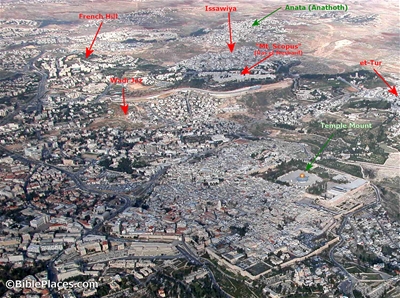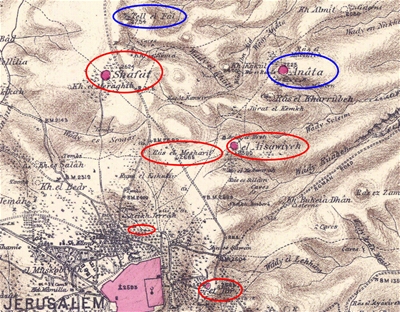Haaretz has an article that reports a new proposal by Boaz Zissu of Bar Ilan University (the Hebrew version has a small photo and map). He suggests that Nob is near a quarry that he excavated on the northern end of the Kidron Valley. The strange thing is that he comes to this conclusion based on what he did not find. He found a quarry, but no ancient settlement. He found pottery, and concludes that it must have come from somewhere nearby, and perhaps that somewhere was Nob. Perhaps.
In favor of his identification is this: his site is between Anathoth and Jerusalem, which matches the general location given in this important geographical passage:
Isaiah 10:28-32 (NIV) “They enter Aiath; they pass through Migron; they store supplies at Micmash. They go over the pass, and say, “We will camp overnight at Geba.” Ramah trembles; Gibeah of Saul flees. Cry out, O Daughter of Gallim! Listen, O Laishah! Poor Anathoth! Madmenah is in flight; the people of Gebim take cover. This day they will halt at Nob; they will shake their fist at the mount of the Daughter of Zion, at the hill of Jerusalem.” (Cf. Neh. 11:32.)
Against his identification is the fact that he found pottery from the end of the Iron Age, but an important biblical passage indicates that Nob was inhabited in the early Iron Age (1 Sam 21-22). Though not mentioned explicitly, most believe that the tabernacle was located at Nob when Saul ordered the slaughter of the priests. The absence of pottery from Iron IIa doesn’t prove that the quarry is not (near) Nob, but before an identification can be made with any certainty, such pottery must be found.
Of greater concern is the apparent methodology. I stress “apparent” because I am basing this on the newspaper article and not on the archaeologist’s proposal itself (and there may be a great gulf between the two). The problem seems to be that a site is found (or apparently found) and it is assumed to be a certain prominent place mentioned in the Bible. In fact, there are several places that this site could be, as you can see from the Isaiah passage quoted above. Scholars are reasonably certain where Anathoth is (modern Anata), and no one doubts the location of Jerusalem. But there are two other sites that are yet unidentified and this quarry could be related to either of them.
There are hundreds of unidentified tells and hundreds of sites mentioned in the Bible and other ancient texts that we cannot locate. Matching the two is not always easy, especially in a land where inscriptions are rarely preserved.
Most geographers follow Albright in locating Nob near what is known today as Mt. Scopus (Ras el-Mesharif). This is where Edward Robinson was looking as well, though his attempts to find ruins were “without the slightest success” (Biblical Researches 2:150). Aharoni suggested that Nob was just over the hill at Isawiyeh (Land of the Bible, p. 393), but Rainey thinks either Madmenah or Gebim could be Isawiyeh and Nob is el-Mesharif or further south, et-Tur (Sacred Bridge, p. 235). An important factor in these identifications is Isaiah’s mention of shaking the fist at Jerusalem, implying that the two can see each other.
Everyone agrees that the solution cannot be determined without archaeological remains from the time periods in which the site is mentioned in the historical texts.


2 thoughts on “Where is Nob?”
Todd, thanks for your excellent article, blending biblical exegesis, modern scholarship, media tools, and a personal familiarity with the Land of the Bible. We are grateful for your scholarship.
Gabriel Barkay suggested that Nob was French Hill, based on the fortress that was found there (A Late Iron Age Fortress North of Jerusalem, by
Gabriel Barkay, Alexander Fantalkin, Oren Tal, in Bulletin of the American Schools of Oriental Research, No. 328 (Nov., 2002), pp. 49-71) Of course, I am a little biased since when we lived in French Hill this fortress was literally in our backyard.
Charlie